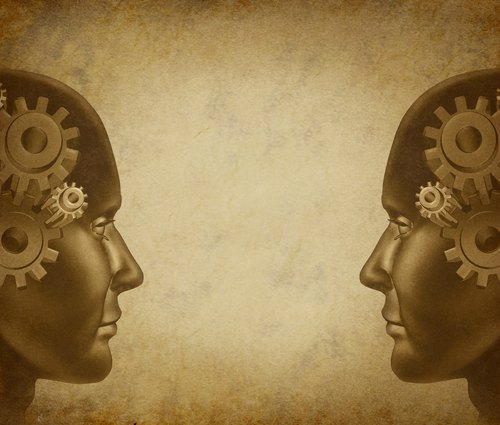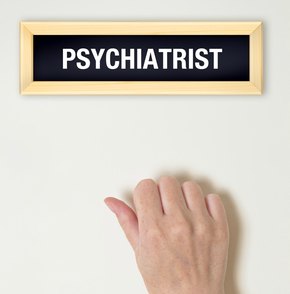“Today, we’ll try aversion therapy. Every time you say something stupid, I’ll spill a bucket of water on your head”

Introduction
This article gives you an insight into psychiatry treatment as it was without pharmaceutical drugs. Pharmaceutical drugs like all chemicals are a poison to the body and mind. As I have said on many occasions one cause of body dysfunction is ultimately is ingesting food not designed for the human body, lack or no exercise, and no stress release. In this article I want to introduce to you what psychology and true psychiatry is. I must stress here that in my opinion 95% of psychiatric problems have physiological ( biological ) origins, so if you are faced with any of these conditions such as depression, anxiety, bipolar disorder, schizophrenia, panic attacks etc, fix your gut first ( read the articles on the microbiome ). I submit therefore, no amount of psychotherapy or psychoanalysis will fix anything unless the gut is functioning correctly.
The Early Years

Psychiatric Treatments
If we are to avocate avoidance of psychotropic drugs we need to be aware of alternative treatment, which we alluded to in previous articles, so so called psychosocial approach or psychotherapy. Even Hippocrates rejected demonology and said the mental disorders are a result of a disturbance in the balance of body fluids. Even the greek and Roman physicians followed this approach and argued for a more humane treatment of the mentally ill, suggesting the importance of pleasant surroundings, exercise, proper diet, massage and soothing baths. Advocating the removal of such treatments as bleeding, purging and mechanical restraints. Unfortunately, the middle ages saw a resurgence of ignorance by association with the mentally sick and demons, satan and evil spirits, as such many of the mentally ill were beaten, starved and tortured as if the psychiatric staff were punishing the devil. Many of the mentally ill were tried as witches and were executed.
The House of the Insane
The lunatic asylums were no more than filthy dungeons until in 1792 Philippe Pinel took the same approach as the Greeks and Romans all those years ago and unchained the sick and began treating them humanely. The wheel had spun 360 degrees. It was diseases like syphilis that convinced medicine and psychiatry at the time that mental disorder was indeed biological in nature since the disease not only destroyed the nervous system but gave rise to delusion and hallucination. Although the general public even in 1900 viewed mental asylums with fear and horror, it was Clifford Bears who developed manic depressive disorder and was confined to an asylum that enlightened the general public. After 3 years he recovered, and went on to publish a book ‘ A mind that found itself’ in 1908 which educated many of the public about mental illness and its treatment.
Mental Health Practitioners
In the 50’s and 60’s the psychiatric profession established a team made up of a psychiatrist, a clinical psychologist, and a psychiatric social worker, and even a psychiatric nurse. Today, most psychiatrists work alone not even adequately analysing the problems of the patient except diagnosing their condition based on the definitions contained within the DSM, and prescribing an ‘appropriate’ chemical to relieve their symptoms temporarily.
Psychotherapy

Modifying Behaviour by Psychotherapy
Old school psychiatrists that believe more in non toxic therapy as opposed to medicating the patient still exist such as David Healy, Grace Jackson, Peter Breggin and others.
Psychotherapy uses one on one therapy sessions to assist mentally disturbed individuals in modifying their behaviour and feelings to deal with stress and become more socially acceptable to general society. Either the psychoanalyst ( or psychotherapist) encourages the individual to understand their unconscious motives and conflicts that is driving their behaviour, or simply teaching them how to make changes without digging up their past. Both techniques require communication between the patient and the therapist, where the latter encourages his/her patient to express their ultimate fears, emotions, and experiences without judgement.
Efficient Psychotherapy depends upon an Efficient Psychotherapist
Henry VIII is in therapy with Anne Boleyn : “So Henry, when you say ‘ Off with her head ‘, what I’m hearing is I feel neglected”
To understand the practicality of this in today’s psychiatric world of biological treatment Dr Peter Breggin informs us that psychotherapy is not without its limitations. Efficient psychotherapy and counselling is dependent on the personal quality of the therapist. It appears that psychiatrists who want to perform psychotherapy are under pressure by the psychopharmaceutical mode of practice that has become so prevalent. I am sure that associations like the NIMH do not encourage such ‘archiac’ practices as psychotherapy and/or psychosocial. However, what helps people is a caring attitude toward the patient from an understanding therapist genuinely interested in helping solve their problems. The ‘Human Factor’ is always a ‘Limiting Factor’; even if the therapist is having a bad day they must mask their own feelings when dealing with a psychologically fragile patient for obvious reasons. Like any one on one communication, the therapist must truly want to help their patient and equally the patient must exercise personal responsibility in wanting to be helped, otherwise both parties will move in the wrong direction and benefit will be lost. The biggest obstacle in our modern society is time and money. These therapy sessions can potentially last for months even years at a rate of 1 hour/week and then there is the cost.
Health Insurance

The Mental Health Parity Law
This could be the biggest obstacle in terms of treatment. At least in US law mental health and physical health are equally important (well that is what is written). I am not an insurance expert but I understand that a law called the ‘Paul Wellstone & Pete Domenici Mental Health parity and addiction equity act passed in 2008 stipulates service coverage for mental,behavioural health and substance use disorder must be comparable to physical health coverage ( All working Americans should be aware of this Mental health parity law ). This means that depending on your insurance coverage which will probably include some ‘copay’ arrangement, these payments must be the same as physical health and mental health treatment. If your insurance plan covers Mental health treatment it may have restrictions on certain diagnosis (It is important to check on any exclusions). However, some plans that are allowable in law can have you copay $20 to see a psychologist and copay $10 to see a primary care physician.
Mental Health Insurance Plan Restrictions
All insurance companies have deductibles (to prevent the insurer from claiming everything possible from the insurance company large and small), so whatever treatment your insurance company is paying for, nothing is reimbursed until you pay the deductible ( some plans pay for mental health costs after part of the deductible is paid, but will not cover physical health treatment until the deductible is fully paid.). Although the parity law prevents insurers from putting firm annual limits on the number of visits to say a mental health therapist, they do reserve the right however to evaluate a particular case to determine if further therapeutic sessions are necessary. The other problem maybe that the particular therapist or psychiatrist may not accept a particular insurer because the reimbursement rates are too low, so that needs to be checked prior to your starting any treatment. This issue of acceptance applies to ‘out of network providers’ as well.
Cost Effectiveness
So it’s one thing to recommend non toxic psychotherapy, it’s another to pay for it. It would be useful to do a comparison between a years worth of therapy sessions versus taking a poisonous drug for the same time, but if the copay is the same then is no issue since the deductible will be the same. In any event eating the correct food and supplementing is the most cost effective because you are avoiding both mental health treatment and primary care treatment and the poisons that accompany the treatment, not to speak of the insurance deductible and copayments.
The British Experiment
In 2005 2 gentlemen David Clark, professor of psychology at Oxford University and Richard Layard an economist at the London school of economics and a member of the house of Lords managed to secure funding to the tune of $40 million in 2008 to establish 35 clinics manned by 1000 therapists, social workers and psychology graduates covering a 1/5 of England. Today that budget has escalated to $500 million. The project called ‘Healthy Minds’ is set up so a troubled individual can immediately talk to a psychological wellbeing practitioner who will carry out an hour long appraisal of your problem and decide an appropriate therapy. The therapy sessions that are established are completely free for UK residents and the current system screens around 1 million people/year.
Healthy Minds Works
As the project architects state it is important that fast follow-up to call backs or rapid email response is essential otherwise the courage for a person in need to at least call the helpline dissipates quickly, since most people are embarrassed to even ask for mental health therapy. No one should be embarrassed to ask for help, if you in trouble or the walls are closing in then somebody should be there to lend a hand. If everybody were willing to ‘step up to the plate’ then our society that has become a majority of have not’s and small minority of “I am alright Jack” or “ sorry I don’t have the time to help” would be better off. One caller sent an email and received a call within minutes upon receipt of the email at Healthy minds and as the caller later said “ I was having these terrible thoughts about what I might do and honestly, I was reluctant to talk to anyone because I thought they would lock me up”.
A Great Step in the Right Direction
So the question you should be asking is “ What incentive does the government have in funding such a program ?”. The answer according to the article is that providing such assistance to people reduces lost productivity within the workplace, which, annually is huge amount of money considering the 1 million people that have already ‘signed up’ for help. In my opinion this is great leap in the right direction and I applaud David Clark, and Richard Layard for laying the foundation for such a positive, essential service. This service has become so popular that most by pass their local physician..which is an argument stated by critics….well let me say this, by avoiding your local physician you are going to save your life since most physicians can’t even treat primary care adequately, let alone mental health, so critics get your head out of your a** and realise you don’t need allopaths to be part of this equation or any equation for that matter.
Operational Problems
The only problem is that therapists are booked solid every day of the week and juggling 25 patients simultaneously and there is a high turnover of psychological well-being practitioners that conduct the initial interviews, but of course this part of project could be computerised, which existed back in the 80’s when Joseph Weizenbaum developed ELIZA that simulated a therapeutic counselor acting purely as a non judgemental person centred therapist without understanding but with AI this could easily be upgraded. Having said that people in need of help, the last thing they want to pour their heart out is a computer interface.
Am I Mssing something??
In 2008 the ‘Healthy Minds project received $40 million in funding revenue in the UK to provide something for the proletariat, the working man and woman, a mental health service to help people. In the same year the US congress sanctioned a $700 billion bail-out for the banks that through greed and power had brought their enterprises to the brink of bankruptcy except for Lehman Brothers that became ‘ballast off a sinking ship’. This enormous amount of money was almost unconditional. Then the very people that had allowed it to happen by forcing congress to walk away from the Glass-Steagall act which was a financial protective measure ( regulation and the separation of commercial and investment banking to ensure there was not another Wall street crash ), did not receive even as much as a parking ticket. Some of these very people then became members of the presidential administration like Dick Poulsen and Co. Even 1% of that amount could have easily established something more worthwhile like the US equivalent of Healthy Minds..so I ask again..Am I missing something ??.
The Behavioural Therapist
versus
The Psychoanalyst

Maladaptive Behaviour
Thirty years ago their existed some controversy and constant disagreement between Behaviour therapists and Psychologists were the former always believed that once a ‘maladaptive behaviour had been changed the patient was cured. Whereas the latter always believed that maladaptive behaviour is only a symptom of an underlying condition. Their view was analogous to physical disorders and considered it futile to treat symptoms without removing the underlying pathology. Does this sound familiar..it should..because this is exactly how most medical physicians behave today..drugging symptoms and ignoring the source of the problem…papering over the cracks as I have said before. Back in the day these insight therapists as they were known considered for example a Phobia as only a surface expression of a more deep seated problem, and by simply treating a surface symptom will simply trigger ‘symptom substitution’. (substituting one symptom with another).
On the other hand Behaviour therapists argued that the maladaptive behaviour is simply a maladaptive habit which, once adjusted, is replaced by a more socially acceptable habit. Apart from the child that has been abused and psychologically abandoned ( Charles Manson comes to mind) by a prostitute mother for example, then most maladaptive behaviour and cognitive dysfunction stem from physiological roots. Furthermore, we know that if the body becomes unbalanced physiologically or psychologically it will try to adapt but in doing so it will express symptoms so I would tend to side with the psychoanalysts because in the majority of cases there will always be an underlying problem.
Freud vs Jung
I believe it is agreed that two of the pioneering psychologists of the 20th century was Sigmund Freud( 1856-1939 ) and Carl Jung (1875-1961). Jung was very influenced by the work of Freud, meaning that he agreed with his hypotheses except for Freud’s ‘Oedipus ( Electra ) Complex’ which defined a child’s ( Oedipus for boys, Electra for Girls) unconscious sexual desire for the parent of the opposite gender at the exclusion of the other parent, and his emphasis on infantile sexuality. I think we have to appreciate that Freud’s ‘obsession’ with sexuality and human development was a bias driven by the Victorian thinking of the time. There were other differences of opinion as well, especially the cause of behaviour which was driven by past experiences particularly in childhood as thought by Freud versus Jung’s theory that was thought to be driven by past experiences in addition to future aspiration, and the nature of unconsciousness. Freud defined the unconscious as a storehouse of unacceptable repressed desires specific to the individual. While Jung felt that it is repressed memories specific to an individual and our ancestral past.
Personality

ID
Our goal in this discussion is to see what and how governs behaviour, since it is this human trait that has many facets whether to heal or kill and everything in between. The building blocks of personality are inherited but its final development is honed from learning and experience. Freud classified personality in 3 stages ID,EGO AND SUPEREGO which finally interact together as we develop from an infant to adulthood. ID which is present in the newborn infant consist of basic biological needs; to eat, drink, eliminate waste, avoid pain/aggression and pleasure/reward. At this stage the requirements are primitive insofar as they need to be satisfied regardless of external circumstances.
EGO
As children our EGO becomes active when we learn that our basic instincts and needs can’t always be immediately met. Hunger cannot be satisfied until food is provided, while waste elimination might be delayed depending on tha vacancy of the toilet ( assuming that the child is beyond the diaper stage ), and striking someone may have punishable consequences ( My Aunt always referred this as ‘ a smackable offence’), this however, is more of an impulse than a need. The EGO should always follow a reality principle, i.e certain gratifications must be delayed until the right environmental conditions prevail. So the EGO becomes a controlling influence over ID.
SUPEREGO
The SUPEREGO, must be active as the executive control management based on values and morals of society that is taught to the child; what is acceptable and what is not. Its development is in response to parental rewards and punishments, and then becomes a barrier causing anxiety over love from a parent if the barrier is breached. Freud referred the anxiety as unconscious whereas the conscious component is guilt. That’s why we ask ourselves “ do we have a conscious”. The SUPEREGO may be weak in some ,culminating into the lack of socially acceptable standards and few behavioural constraints. The stable personality will integrate the 3 stages, which is to orchestrate ID that seeks pleasure, the EGO that tests reality and the SUPEREGO that strives for high achievement.
Factors that Shape Personality
Modern psychiatrists, although acknowledge Freud’s contribution to personality, in reality, as we appreciate today, an individual is influenced and therefore streamlines their personality based on people they encounter, surrounding society and culture, coupled with their biological requirements. As I intimated above a normal individual will satisfy his/her biological needs within acceptable societal boundaries. Furthermore, individuals want to behave in ways that are consistent with their self image, experiences and feelings ( what I would call their ‘comfort zone’). Well adjusted children who are scolded say, for causing harm on their baby brother or sister, will feel ashamed and sub consciously integrate this into their self image. The weaker individual who goes through the same experience may decide that their parents dislike them and furthermore they may deny the values of their parents to feel more comfortable with their own self image, and a reaction of denial where they believe there was nothing wrong with their actions.
What’s the Use of Therapy
Based on my statement in the introduction and the reiteration of Pinel’s quote ‘that the seat of insanity lies within the gut’ I believe therapy is invaluable in adjusting an individual’s opinion of themselves, if that self opinion is not socially acceptable; in other words, too high or too low an opinion, and to correct psychological balance. As another member of the human race we must be in position to adapt to various situations without becoming overly anxious, or stressed, and if we do than we can adjust the imbalance. I have often expressed how essential balance is to the human organism and nature in general. We can witness this every day of our lives that existence and nature can only function efficiently if both are in harmony. If they don’t, and their balance is upset, then only chaos can prevail. This applies to the human and every living organism where psychological and physiological balance is crucial for normal existence without pain, without chaos. In essence therefore therapy plays a role in adjusting balance in the human individual.
Normal Psychology
To measure ‘Normal’ we can take the list from Atkinson & Hilgard’s book ‘The introduction to Psychology’:
- Efficient perception of reality ( the correct appraisal of one’s reaction, capability and interpretation of what’s going on around them)p
- Self knowledge ( the self awareness of one’s motives and feelings or behaviour)
- The ability to exercise voluntary control over behaviour ( automatic confidence of behavioural control and correctly restrain sexual or aggressive impulsive behaviour )
- Self esteem and acceptance ( to appreciate one’s self worth and the acceptance of other individuals, and respond accordingly without the necessity to be too opinionated)
- The ability to form affectionate relationships ( to be comfortable around people and form close relationships and be sensitive to the others and their feelings without the need to impose one’s feeling to gratify oneself).
- Productivity ( the ability to correctly channel one’s energy in useful enterprising activity, with a healthy zest for life without over taxing oneself).
You can consult with the psychiatrists ‘sorcerers manual the DSM to get a complete list of what is considered abnormal behaviour except for the stupid entries like ‘shoperholicsm’ or masturbatory insanity (you can spot these people easily..they have buck teeth,,,lol), or kvetching ( habitual complaining..maybe that’s not in there YET, or frotteurism (you don’t want to know).
Conclusions
We have taken a brief walk into psychiatry’s past and discussed Freud and Jung’s thoughts on the origins of cognitive dysfunction. I believe that personality is a cornerstone of understanding behaviour and an important part of therapy in adjusting balance in the human individual. The British Healthy minds project is groundbreaking and a move toward non-toxic therapy as it was before the psychiatry profession was purchased by the pharmaceutical industry.

[Melvin Udall enters the office of his psychiatrist Dr. Green.]
Melvin Udall: Hi. Help!
Dr. Green: If you want to see me, you will not do this. You will make an appointment.
Melvin Udall: Dr. Green, how can you diagnose someone as an obsessive-compulsive disorder and then act as though I had some choice about barging in?
Dr. Green: There’s not going to be a debate. You must leave.
Melvin Udall: You said you could help me! What was that? A tease?
Dr. Green: I can help you if you take responsibility to keep regular appointment –
[Melvin suddenly interrupts.]
Melvin Udall: You changed the room around.
Dr. Green: Two years ago. I also regrew my beard, but you’re not interested in changes in me. So, it’s like I always –
Melvin Udall: Sh. I don’t have this mountain of available time. I have to get to my restaurant on time. Now, do you know how hard it was for me to come here?
Dr. Green: Yes.
Melvin Udall: Thank you.
[He starts for the office.]
Dr. Green: No, we’re not doing this now.
Melvin Udall: I changed just one pattern. You always said I should.
Dr. Green: No. Nope.
Movie quote ‘As good as it gets” (1997)
References/Acknowledgments:
- Medication madness Book 2008 Dr Peter Breggin
- England’s Mental Health Experiment: No-Cost Talk Therapy Benedict Carey 2017 New York Times
- Anatomy of an Epidemic Robert Whitaker Book 2010
- ‘Introduction to Psychology’ Rita & Richard Atkinson, Ernest Hilgard Book 1983
- Carl Jung Simple psychology 2014
- What you need to know about Mental Health coverage American Psychological Association
- Movie quote ‘As good as it gets’ 1997 Wikiquotes
About The Author: Eric Malouin
In terms of my heritage I am not a thoroughbred, I am half English from England and half French Canadian from Quebec. Having spent the last 10 years in Medical research I thought that it was time to share my passion for true health to anybody interested in maintaining health without using conventional medicine. Once in the distant past I lived off conventional grocery shelves until you visit the man in the white coat and then a light shines through the darkness that you had not realized you were in… I was in..the twilight zone….I cured my own problems using natural methods, although they were not a big deal since I have always exercised..jogging every morning and tennis 12 hours/week, swimming but I was eating a lot of devil food that was causing my body to become unbalanced..an easy fix..reprogrammed my taste buds and gave the food back to the devil…lol
I hope you enjoy the articles……
Regards,
Eric
Contact the Author: emalouin@gmail.com